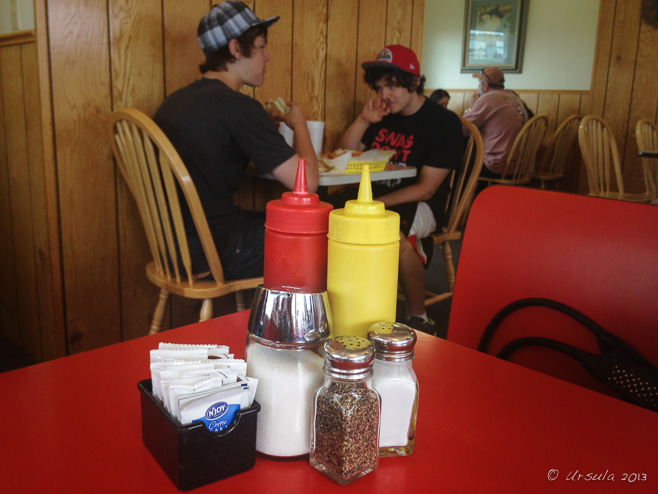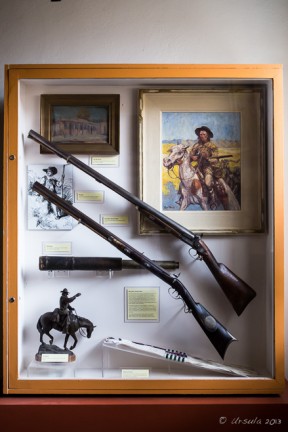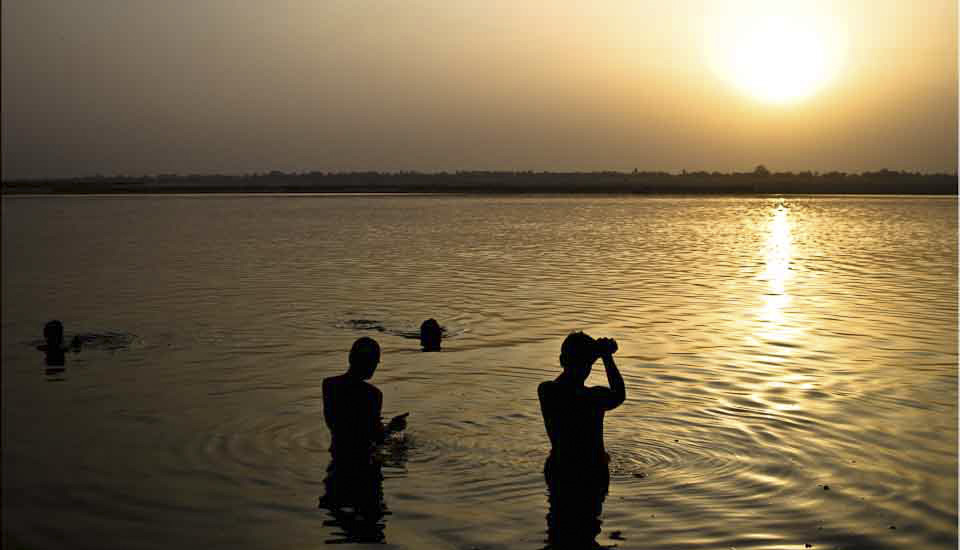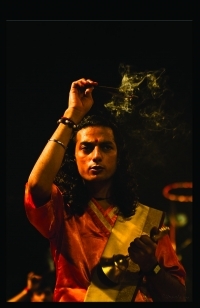 American and New Mexican Flags
The flag of New Mexico is a perfect example of mixed cultural heritage: the Zia (Native American Pueblo People) Sun Symbol, the sacred four: four seasons, four times of day, year and of life, and the four obligations, radiating around a unifying circle; depicted in the colours of the Standard of Aragon, which was carried into the region by the Conquistadors. (iPhone 4S) I loved New Mexico.
What’s not to love about a state that reveres spiritual ancestors, country and western legends, Mother Mary, and extraterrestrials – seemingly in equal measure! It’s not that I have any particular affiliation with any of the above, but I admire a culture that allows for – and celebrates – such diversity.
We were driving south from Monument Colorado, on the way to Santa Fe New Mexico, as part of a swinging loop into Houston Texas. The further south we got, the dryer the landscape and the more “modest” the surrounds.
 Georges Drive Inn, Walsenberg CO
Just north of the Colorado-New Mexico state line, we stopped for lunch. Eschewing the Kentucky Fried Chicken, the McDonalds, and the Taco Bell clumped together at a road stop in the small city of Walsenberg CO, we decided to take a chance on a tiny diner across the road. Clearly popular with locals, people were queued out the door for tables and for take-away. Like a blast from the past, the formica tables, the condiments, and the menu (patty melts and tinned peaches), were unchanged from my childhood. (iPhone 4S) There is something in the New Mexican air: hot, dry air; crackling with electricity and thrumming with life. No wonder the state is home to artistic communities and a rich mix of traditional practices and new-age spiritualism. The land vibrates with possibilities and shimmering colour.
New Mexico is where New World Spanish heritage meets the American “Wild West”. Kit Carson is like an epitome: described by Wikipedia as a “American trailblazer and Indian fighter”, he is elsewhere called an “American frontiersman, trapper, soldier and guide… one of the great heroes of the Old West”.
Kit was fluent in Spanish, Apache, Navajo, and several other American Indian dialects, making him an invaluable guide. He was twice married (once widowered, once divorced) to women of Native American blood, before marrying a young Catholic from a prominent Hispanic Taos family. They had eight children together. They also rescued three Navajo children from captivity and raised them as part of their family.
In spite of his empathy with Native Americans, Kit was held responsible for implementing the round up and exile of 8,000 Navajos in 1864. During what came to be called “the Long Walk” – 300 miles (480 km) from Fort Canby to Fort Sumner, New Mexico – about 300 people died, with many more dying at their destination, a desolate tract on the Pecos River.
 Adobe Dining Room
Now a museum, Kit Carson bought this modest Spanish-Colonial house in Taos in 1843 and he and his growing family lived here for the next 25 years. (iPhone 4S)  Chillies and Adobe – Taos  Mounted Prong Horn and Crucifix
A private corner in a dark shop illustrates the eclectic nature of the state: a taxidermied prong-horn sheep head and other various animal bones; historical photos; religious iconography; and anthropological paraphernalia.  Dancing the Country Two-Step
In the Santa Fe Plaza, a country and western band plays while a couple dances a two step.  Boots on the Line
The country-western theme repeats around Santa Fe. Our motel made liberal use of western wear …(iPhone 4S)  Western Saddle
… and old saddlery. The decor extended through to the rooms; we stayed in the Willie Nelson Room, complete with portraits of him and framed “On the Road Again” lyrics.  Camel Rock
New Mexico is home to twenty-two Native Indian tribes – modern descendants of Ancestral Pueblo People and members of the Navajo and Apache Nations. Today, they continue to practice traditional ceremonial dances, arts and crafts, language, and lifestyle – while also developing modern casinos, resorts, hotels and golf courses to improve their economic status. Across the road from this distinctive rock formation is the glitzy Camel Rock Casino, owned by the Tesuque Pueblo.  Cliff Dwellings
New Mexico is one of the “Four Corner” states that are home to numerous ruins of cliff dwellings – ancient homes of the Ancestral Pueblo People. (iPhone 4S)  Pojoaque Pueblo
Once you are off the main highways, shrines punctuate the roadside. Everywhere there is a marriage of Christian and Native American symbolism.  Roads in the Mesa
It’s a wide open country… (iPhone 4S)  The Healing Church
El Santuario de Chimayó is a delightful Roman Catholic church, built in 1813 on a site that was already a pilgrimage shrine.  Crosses on the Fence
El Santuario de Chimayó is one of the most important Catholic pilgrimage sites in the United States; 300,000 pilgrims visit each year with hopes and prayers for healing – for themselves or for their loved ones.  In the Madonna Garden
El Santuario de Chimayo is surrounded by the Sangre de Cristo Mountains of Chimayó.  Our Lady of Sorrows
The gardens of El Santuario de Chimayó are tranquil, with plenty of places to reflect.  Wooden Door
When the Spanish arrived in the New World in the 1500s, they were committed to converting the native Pueblo Indians to Christianity. For the most part, they succeeded – but American Indian artistic sensibilities continued to find influence, even in the local Catholic Church.  Crosses
A pathway and a row of crosses along the Santa Cruz River mark the northeast boundary of the sanctuary grounds.  Cross on the Fence
El Santuario de Chimayó has been called the “Lourdes of America” because of the healing powers believed to be in the area.  Cathedral Basilica of St. Francis of Assis
Built between 1869 and 1886, Saint Francis Cathedral is the “mother church” of Santa Fe.  Saint Kateri
Kateri Tekakwitha (1656–1680), an Algonquian-Mohawk woman from New York State, was the first North American Indian to be beatified. This statue is by Jemez Pueblo sculptor Estella Loretto.  Woman and the Sands of Time
At the nearby New Mexico Museum of Art, local artists find expression in the outdoor spaces.  Ranch View Motel – Vaughan
Driving south from Santa Fe on Interstate 285 South, we were quickly in a lot of hot, dry, deserted empty space. (iPhone 4S)  William Ware “Mack” Brazel
Outside the Roswell UFO Museum is a tribute to Mac Brazel who, in July 1947, found the strange debris that lead to the “Roswell Incident.” Inside the museum there are a lot of printed materials investigating the possible explanations. After an exploration of the possibilities of extra-terrestrial life and another lunch of Mexican-style re-fried beans, we continued south to the border… where somewhat surprisingly, everything changed once we left New Mexico and entered Texas!

I can’t help but wonder what “American” means when the regions within the country are so clearly distinctive and different.
It certainly makes for fascinating road-trips.
Happy Travels!
Photos: 18-20May2013
Posted in Culture,Landscapes,Travel,USATags: architecture,biography,blog,landscape,Photo Blog,travel,Travel Blog,Ursula Wall
 Inside Agra’s Red Fort
Built by Akbar the Great in red sandstone, and expanded and renovated in white marble by Shah Jahan, Agra’s Red Fort is a testament to Mughal architecture. Agra, in Uttar Pradesh, northern India, is more than just the home of the Tāj Mahal. Once the capital of the Mughal (Moghul) Empire, ruling over all of India from 1556 to 1658, Agra houses many splendid Mughal-era buildings, three of which – the legendary Tāj Mahal, the wonderful deserted city of Fatehpūr Sikrī, and the magnificent Agra Fort – are UNESCO World Heritage listed.
In its current form, Agra Fort – also known as Lal Qila, Fort Rouge and the Red Fort of Agra – was built by the Mughals, particularly Akbar, Jahangir and Shah Jahan, as a walled city. The 380,000 m2 (94-acre) fort, stretching along the Yamuna River and protected by seventy-foot high walls, once housed as many as five hundred buildings in Bengal and Gujarat styles. Some of these original structures were razed to make way for Shah Jahan’s glorious white marble palaces. Others were destroyed by the British between 1803 and 1862 to construct barracks. While only a few of the Mughal buildings have survived, they speak of a rich history and are well worth a visit.
I’ve visited the fort twice: in 2008, on a private trip with my husband, and in 2012 on a group photo-tour with photographer Karl Grobl and local guide, DV Singh.
I loved exploring it and its stories both times.
 Amar Singh Gate
Tourists enter Agra Fort through the massive red sandstone Amar Singh Gate.  Agra Fort Walls (2008)  Visitors Photographing the Visitors
We all have our cameras at the ready as we enter Agra Fort.  Jahangiri Mahal (2008)
A blend of Hindu and Central Asian architecture, the Jahangiri Mahal held the apartments of the Rajput wives of Akbar the Great.  Hindu Art
In the 11th century, the ruling Hindu Sikarwar Rajputs had a brick fort here. Some of the treasures from that era are still housed on site.  Diwan-i-aam
Built by Shah Janan in 1628 to welcome kings and dignitaries, …  Diwan-i-aam
… the many-pillared Diwan-i-Am (Hall of Public Audience) allowed everyone a view of the throne.  Woman in the Diwan-i-aam  Red Roof Truss (2008)  Tomb of John Russell Colvin (2008)
Colvin, lieutenant-governor of the Northwest Provinces of India, died of cholera during the peak of the Indian Rebellion of 1857. His entombment in such a prominent location at Agra Fort, which was at that time a military garrison, is considered by many to be extremely culturally insensitive.  Three-Striped Palm Squirrel
One of the first thing I always notice in India is the wildlife: the birds in the skies and creatures on the ground.  Khas Mahal and the Anguri Garden (2008)
Agra Fort was a walled palatial city; a fortified royal residence. The Khas Mahal was built by Shah Jehan between 1631-40, for his two favourite daughters.  Musamman Burj
Also known as the Saman Burj or the Shah-burj, the Musamman Burj is an octagonal tower standing close to the Shah Jahan’s Hall of Private Audiences, the Diwan-e-Khas.  Mussaman Burj – Palace Rooms
The Musamman Burj is made of beautiful marble with (now dry) fountains, ornamental niches, and delicate lattices so that the ladies of the court could look out on the world without being seen. Water flowed through the walls to keep the rooms cool in the heat of the Indian summer.  Marble Beauty (Composite 2008)
The workmanship, in the inlaid marble (pietra dura inlay) in semi-precious stones throughout the the palace rooms, is stunning.  Palace Prison (2008)
Irony: Shah Jahan, who built large parts of Agra Fort – and who built the Taj Mahal for his beloved wife – was imprisoned by his third son Aurangzeb in the fort from 1658 – in rooms where he had a view of his wife’s mausoleum – until he died January 22, 1666.  The Taj over the Yamuna River Flat
From Agra Fort, the Taj Mahal is visible; less so these days through the haze and smog over the river.  Mother and Child
Most of the visitors to the fort are Indian; my travel companions and I are in the minority.  Inside Agra Fort
The delicate beauty of the Moti Masjid (Pearl Mosque) behind the Diwan-i-Am Courtyard.  Wall and Door  Gate Keeper (2008)  Mosaic on the Gate (2008)  Decoration …
In the old days, the sloped entries to the fort protected against attack by elephant… Today, barbed wire laces the perimeters.  It was an amazing era, leaving behind a legacy of beautiful Indo-Islamic architecture that is a joy to behold and explore. One can easily get lost imagining the lives and loves lived within the city-palace walls. It was an amazing era, leaving behind a legacy of beautiful Indo-Islamic architecture that is a joy to behold and explore. One can easily get lost imagining the lives and loves lived within the city-palace walls.
Namaste!
Pictures: 21April2008 and 17November2013
Posted in Architecture,Culture,India,TravelTags: architecture,blog,environmental portraits,history,India,museum,Photo Blog,travel,Travel Blog,UNESCO,Ursula Wall
 Etching Details
Making fine Burmese lacquerware is time-consuming and labour-intensive. There is something universal about the search for beauty.
We may not agree on what “beauty” is – indeed, Western philosophy has argued conceptions of beauty extensively over time – but we all seek to surround ourselves with objects that are not merely functional, but are also aesthetically pleasing.
One of the many joys of travel, for me, is seeing how “other people” do things – especially in terms of creating functional objects in beautiful forms. From clothing to architecture, people seem driven to decorate themselves and their environments in ways that are culturally and regionally distinctive.
Take Burmese lacquerware for example: it takes time, skill, a steady hand, and an eye for design to transform simple wood or metal surfaces into richly decorated objects.
For centuries, people in Asia have used lacquer made from the resin of the “Japanese varnish tree” or the “Chinese lacquer tree” (Toxicodendron vernicifluum) to give wooden products a tough, durable and water-resistant finish. A simple red lacquered wooden bowl thought to date to the 5th millennium BC was found in Zhejiang, China. Much later, during the Shang Dynasty (ca. 1600–1046 BC) in China, sophisticated lacquer techniques were developed and it became a highly artistic craft.
The Burmese style of making lacquerware, called Yun-de, was introduced into the country by Yun or Laos Shan artisans from the north of Thailand in the mid-1500s. The lacquer, which comes from the sap of the “Burmese lacquer tree” or “Thitsee” (Melanorrhoea usitata), starts out straw-coloured, but turns black when exposed to air. Many layers of lacquer are applied to a bamboo form, each needing to dry for several days before being polished to a smooth finish, engraved with intricate designs, and painted.
“The best lacquerware in [the] world is crafted in Bagan, Myanmar, a village steeped in two hundred years of practice in the craft.” When I visited the U Ba Nyein Lacquerware Workshop in Bagan, I was able to watch some of the steps in the manufacture process.
On a photographic note: I don’t usually opt for black and white, but my original shots were “noisy” with colour, which I thought distracted from the sense of quiet concentration I felt emanating from the workers. Working in black and white also gave me a chance to experiment with different editing processes.
 Weaving the Base
A base for the lacquer coating is made of bamboo strips woven together with horsehair.  Weaving Bamboo
The combination of bamboo and horsehair gives the material strength and flexibility.  Bamboo Pots
The bamboo form is built up in layers.  Chiselling the Base
Bamboo bases are chiselled into the desired form.  Applying Thayo
Thayo, a thick mixture of thitsee resin with ash or sawdust, is layered onto the bamboo forms. Subsequent layers of resin might be thinner.  Pressing and Polishing
Thayo, the thitsee tree resin mixture, can be sculpted while wet.  Engraving Details
Once the many layers of lacquer are dry and polished, detailed patterns can be etched into it.  Etching Lacquerware
All the designs and engraving are done free-hand…  Etching Lacquerware
… taking steady hands …  Etching Lacquerware
… and a great deal of concentration.  Painting Lacquerware
Elaborate designs commonly use red, green and yellow colours – or even gold leaf.  Painting Lacquerware
Large pieces can take a year to complete.  Washing Lacquerware
Even small pieces can take months.  Lacquerware Pots
As well as intricate patterns, designs include pictorial scenes from popular stories, and signs of the Burmese zodiac.  Final Wash and Polish  Sorting Pots and Lids  Wall Display
A range of items are on show in the display area, including hsun, rice bowls with stems and spired lids.  Vases and Table-Ware  Home Decor The advent of plastics, porcelain and metal for use in everyday utensils have greatly reduced the need for lacquerware, and today it is predominantly produced for decorative items and for tourists.
However, while the opening-up of Myanmar has meant more international tourism, it has put whole new pressures on the job market, with young people preferring work in the hospitality sector.
In a recent (February, 2014) news story, Ma Mee Mee, co-owner of the U Ba Nyein Lacquerware Workshop, said: “We are worried that Bagan will lose the battle to save our traditional lacquerware culture.”
 That would, indeed, be a great shame. That would, indeed, be a great shame.
I did my bit, and came home with a small piece of beautifully crafted artwork.
Until next time ~ Happy Shopping!
Pictures: 18September2012
Posted in Craft,Myanmar,Travel,WorkTags: arts and crafts,blog,environmental portraits,Myanmar,people,Photo Blog,travel,Travel Blog,Ursula Wall,work
 Elvis is in the Building! Names drop like musical notes
– and me, once again, am caught without an umbrella…
Apologies for the paraphrase, but when I envisioned dropping the names of some of the musical heavy-weights we had the good fortune to listen to at the Byron Bay Bluesfest 2014, I “saw” the names coming down like rain; like the tears in the old Michael Franti song: Caught Without An Umbrella. Music is like that, I guess; it makes for unusual connections.
I remember, many years ago, walking up to the sales register in a record store with a number of CDs: a 1953 recording of Mozart’s horn concertos; an Australian punk-rock album, popular with under-15s that I was buying for my daughter; the first studio album by Michael Franti’s Spearhead (see: Michael Franti and Spearhead); an older album by a contemporary jazz quartet; an early rock compilation; a classic Tony Joe White collection of “swamp music” and a couple of other disk I have forgotten. The store’s owner-operator raised one eyebrow and looked at me quizzically: “You have an eclectic taste in music,” he pronounced, dryly.
I guess he is right: eclectic, but lazy. That’s one of the reasons I love music festivals like Bluesfest: even though it is billed as “Blues and Roots”, in all honesty, almost anything goes! What better place to sample a broad range of music: from the classic roots to the leading edge; small bands and big names; local and over-seas.
Our first two days got off to a great start (Full Blast and Full Colour) and continued with a rich mix of sounds.
 Get in Early!
Hearing great bands doesn’t always mean seeing them very well. We delighted in listening to tracks from folk-rock singer-songwriter Jack Johnson from a long way back in the big Mojo tent. Zach Gill joined him on accordion for the laid-back crowd-pleaser “Belle / Banana Pancakes”.
Accordion pop music? How’s that for eclectic?  Clairy Browne & The Bangin’ Rackettes
In total antithesis to the soft sounds of Jack Johnson, Clairy Browne & The Bangin’ Rackettes were belting out their brand of jazzy doo-wop in black vinyl dresses and hot red lighting, rounding out another night of varied music.  Clairy Browne
Smaller venues – in this case Delta tent – allow for closer access to performers.  Terrance Simien and the Zydeco Experience’s Grammy
Early Saturday we were in the Cavanbah tent listening to the infectious Terrance Simien as he explained Zydeco (Louisiana Afro-Creole roots) music and showed off the first Grammy he and his band won in 2009.  Another Accordion!
The two primary instruments in Zydeco are the accordion …  Stan Chambers (bass) and Ralph Fontenot (rubboard)
…and the rubboard or frottoir (French for friction strip) …  Audience Participation
… which children from the audience helped with.  Danny Williams
Keyboardist, songwriter, and producer Danny Williams, is proud to be part of both Grammy-winning albums. The most recent one, “Dockside Sessions”, won best regional roots music album in 2014.  Kate Miller Heidke
For a complete contrast, our next stop was for the Elizabethan-dressed, operatically-trained, in-your-face (language warning!) Australian singer-songwriter Kate Miller Heidke.  Dreads, Beads and Tats
Music festivals are not just about the performers –  Face Paint and Cat’s Ears
– people-watching is half the fun.  Neville Brothers
With their distinctive mix of rhythm & blues, funk, jazz, and American R&B, the Neville Brothers, with Charles on saxophone and Aaron with his unique vibrato on vocals, filled the Crossroads tent with soul sounds.  “Bird on a Wire”
I don’t like people messing with my Leonard Cohen, but I can make an exception for Aaron Neville.  Belly Dancer
Back outside in the twilight, local belly dancers shake their stuff.  Camera Setup
Silhouetted against an almost-dark stage, a camera operator waits …  Gregg Allman
… for Gregg Allman, who sits high up on his keyboard like a Southern preacher at his pulpit.  Jeff Beck
The guitarist’s guitarist, Jeff Beck, with Rhonda Smith on bass, follows.  Morcheeba
Meanwhile, in Jambalaya Tent, British band Morcheeba, with their contemporary trip-hop rock, fronted by singer Skye Edwards, are pulling in the younger dance crowd. We started our fourth festival morning with some choice Australian acts (Homegrown Favourites) before sampling performers from around the world in an assortment of musical styles.
 Foy Vance
Early afternoon in the Mojo Tent …  Foy Vance
… singer-songwriter Foy Vance from Northern Ireland sings his original songs.  Nikki Hill
American vocalist extraordinaire Nikki Hill …  Nikki Hill
… set the Juke Joint on fire with early rock classics.  Playing for Change
More happy sounds come out of Mojo Tent as the performers from around the world who comprise Playing for Change sing their up-beat music; …  Chali 2na
… very different from the rap stylings from hip-hop artist Chali 2na in the Crossroads.  James Cotton Blues Band
In Delta, we went back to basics, and enjoyed music from some real blues veterans: singer Darrell Nulisch, harmonica legend James Cotton, and bass guitarist Noel Neal.  Nahko & Medicine for the People
Alternative Australian singer-songwriter and multi-instrumentalist, Xavier Rudd joined the American group Nahko & Medicine for the People on stage for music with strong indigenous (First Nations) references.  India.Arie
Multi-award winning American singer-songwriter, musician, and record producer, India.Arie performed in Mojo. Her R&B sounds and messages of education and empowerment are in contrast with …  KC and the Sunshine Band
… the pure sunny fun and disco party going on in Crossroads, where KC and the Sunshine Band were joined by exuberant leggy dancers.  Harry Wayne “K.C.” Casey
KC first formed the Sunshine Band in 1973 and had a number of disco-pop-funk hits before disbanding it in the early 1980s. The revival group has been performing since the mid-1990s.  Jeffery Reeves on Lead Guitar
Lights, dancers, horns, keyboards: KC and the Sunshine Band was one big party – and the audience was dancing along the whole time. Who says disco is dead? After a second listen to the Cambodian Space Project, we checked out the young British Indie folk-rock performer, Jake Bugg.
 Jake Bugg
Clearly a hit with the younger festival goers, …  … Jake Bugg is big voice from his spot on the stage.  Guitars Lined Up
Elvis Costello’s performance segued from one song to another, with guitar-changes, but no pause and very little patter.  Elvis Costello
With a career spanning almost four decades, countless songs and albums, numerous awards, including an Honorary Doctorate in Music and a Grammy, Elvis Costello’s performance was a fitting culmination of our five days of fabulous music. “And memories come down and me once again
Am caught without an umbrella.”
 Like I said at the outset: lots of names, big and small. Like I said at the outset: lots of names, big and small.
Lots of great music.
Pictures: 18-21April2014
Posted in Music,Performance,PortraitsTags: blog,environmental portrait,environmental portraits,music,musicians,people,Photo Blog,portrait,portraits,Travel Blog,Ursula Wall
 Michael Franti
On stage at Byron Bay Bluesfest, Michael Franti shares his distinctive blend of good vibes, good messages, and good music. Isn’t it funny how we experience a “kinship” with identities whose views and/or behaviour we admire? And, how we feel a “connection” with personalities whose faces are visible in the media or whose opus with which we are familiar? We “know” these people – even though they have no idea who we are.
Music is so evocative that its is no surprise that – although it is a very public medium – it speaks to us at a very private level; particularly if it is music with a message with which we identify. Certainly, music speaks to a time and place, and we often know exactly where we were or who we were with when we first heard a particular song or band.
I confess: I don’t listen to the radio much, unless I am in the car driving. And, I’m more likely to listen to news, views, and music I am familiar with, than I am to listen to anything avant-garde. It is not the norm for me to be up with trends until they are tried-and-true (i.e., no longer trendy!). So, it was pretty unusual for me to be hunting down a band that wasn’t across every bodies lips in 1994, after hearing a short snatch of song that had come through on a clock-radio – tuned to Triple J, an Australian platform for new music – before it turned itself off for the night.
(Double click for the audio clip: Hole in the Bucket, from the 1994 Spearhead album Home.
I was captured by both the tune and the clever lyrics. It was a sort of reggae-rap; again, not my normal fare. My mental associations with the lyrics, as happens with a good poem, shot off in a non-linear manner, connecting to all kinds of images and memories.
The track’s chorus comprises the traditional children’s song: “There’s a hole in the bucket, dear Liza, dear Liza….” Harry Belafonte’s well-known 1961 rendition of this song was on one of the very-few non-symphonic, non-operatic LPs that I had access to as a child. Later, as a young adult, I saw Belafonte perform it live in concert. So, hearing the refrain embedded in a rap song – about a man deciding whether or not to give spare change to an indigent beggar on the street corner – got my attention.
The song is called “Hole in the Bucket”, as I discovered after trying to hum a few bars to the owner-operator of a local independent record store (Do you remember those?). He was able to point me to the disc: Home, the first studio album by Spearhead, Michael Franti’s (then) newly formed band.
I fell in love with the whole album. Whether it is a well-written book or a skillful lyric, I am easily seduced by artfully-crafted words – and the words on that album are adroitly composed: sharp and insightful, with enough honesty to stop short of being maudlin, and enough empathy to keep from being just clever.
“I’m not responsible for the man’s depression
how can I find compassion in the midst of recession?”
In 2000, I dragged a girlfriend out to a Sydney nightclub because Michael Franti and Spearhead were playing. We were amongst the oldest fans at the venue, and were flattered and amused (even though we knew the bouncers were kidding) when we were age-carded at the door. The band were on their third album by then, but had lost none of their energy, or social consciousness. The political messages – and the warm humanity – were still in evidence.
That was a long time ago, and we’ve all grown older since then. But, unlike many of us who become more cynical with age, Franti seems to have retained – and expanded upon – his positive energy. In the intervening years, he has written a children’s book on recycling, helped fund a birthing centre in Bali, produced an award-winning documentary on the effects of war in the Middle East, and sponsored and promoted various fair-trade, whole food, and healthy lifestyle endeavours.
I was thrilled to see that Spearhead, now on their eighth studio album, were on the Byron Bay Bluesfest 2014 lineup. Rolling Stone agrees that Michael has mellowed, and his “formative punk rap … [has] veered toward full-on jam pop.” But, the review of the “All People” album continues: “Well-crafted, unfailingly likable, the music hints at his activist-sage roots; check out the apocalypse-minded, Matrix-produced rap-along “11:59.” For those who plan to go down dancing, he’s a solid man to have on the mic.”
I can’t argue with that! His Sunday night set in the Crossroads tent was one long party.
 Michael Franti
Centre stage in the Crossroads tent, Michael Franti has the crowd jumping up and down with positive energy from the very beginning.  Michael Franti
He performed the songs from the most recent album, All People.  Spearhead
Michael Franti has always surrounded himself with excellent musicians.  J Bowman
The current lineup of Spearhead includes guitar virtuoso J Bowman, who also acts as production partner to Franti.  J Bowman
He contributed an infectious energy to the gig.  Michael Franti
The performance moved forward with exuberance and without pause, …  …alternating between “big” moments from the stage …  … and more intimate moments from the floor …  … as Franti climbed down into the crowd.  Six-foot-six, habitually barefoot, Michael Franti is a regular yoga practitioner.  Backlit, J Bowman wails his guitar.  Henry Wagons
In true festival fashion, eccentric Australian showman Henry Wagons was invited to join Spearhead on stage…  Rocking On!
… after meeting Michael at an afternoon session of Rockwiz, an Australian television quiz show series.  Carl Young on Bass
Versatile musician Carl Young has been with Michael and Spearhead since 1994.  Franti in the Crowd  Kids on Stage
Franti calls all the kids in the audience onto the stage for one of the final songs…  Sara Agah; Behind every Good Man…
As part of the “after party”, while Michael gets back into the audience, his partner, Canadian nurse and jewellery designer, Sara Agah, and the other “back stage” people, are called out front. 
Happy music with positive messages –
How could you help but leave smiling?
Pictures: 20April2014
Posted in Music,Performance,PortraitsTags: American,blog,environmental portrait,environmental portraits,music,musicians,people,Photo Blog,portrait,portraits,Travel Blog,Ursula Wall
« Older posts
Newer posts »
|






















































 It was an amazing era, leaving behind a legacy of beautiful
It was an amazing era, leaving behind a legacy of beautiful 























 That would, indeed, be a great shame.
That would, indeed, be a great shame.




















 Like I said at the outset: lots of names, big and small.
Like I said at the outset: lots of names, big and small.






















































.png)


Everyone should visit this part of the states just once. Highly recommend it